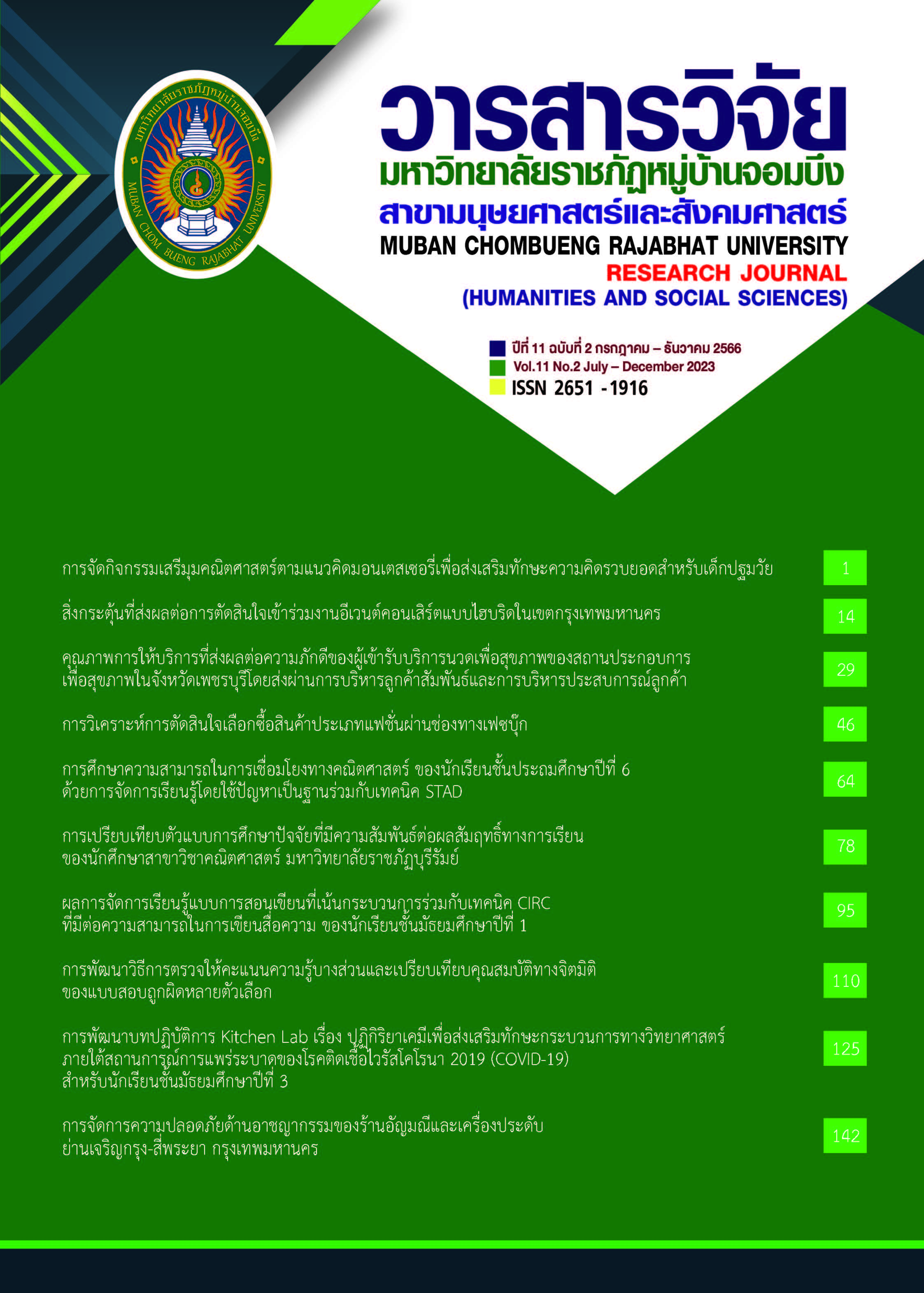การพัฒนาวิธีการตรวจให้คะแนนความรู้บางส่วนและเปรียบเทียบคุณสมบัติทางจิตมิติ ของแบบสอบถูกผิดหลายตัวเลือก
คำสำคัญ:
แบบสอบถูกผิดหลายตัวเลือก, วิธีการตรวจให้คะแนนความรู้บางส่วน, คุณสมบัติทางจิตมิติบทคัดย่อ
งานวิจัยนี้มีวัตถุประสงค์เพื่อ 1) เพื่อพัฒนาวิธีการตรวจให้คะแนนความรู้บางส่วนของแบบสอบถูกผิดหลายตัวเลือก 2) เพื่อเปรียบเทียบคุณสมบัติทางจิตมิติตามทฤษฎีการทดสอบแบบดั้งเดิมของแบบสอบถูกผิดหลายตัวเลือกที่มีวิธีการให้คะแนนความรู้บางส่วน 4 วิธี ประกอบด้วย วิธีการให้คะแนนบางส่วน 50 (PS50) วิธีการนับ 2 (Count-2) วิธีการเพิ่มคะแนนตัวเลือกที่เว้นไว้ (LO) และวิธีประยุกต์การเพิ่มคะแนนตัวเลือกที่เว้นไว้ (MLO) ตัวอย่างวิจัย ได้แก่ นักเรียนชั้นมัธยมศึกษาปีที่ 6 แผนการเรียน
คณิตศาตร์ -วิทยาศาสตร์ จำนวน 1,178 คน เครื่องมือวิจัย ได้แก่ แบบสอบถูกผิดหลายตัวเลือก เรื่องเคมีอินทรีย์ จำนวน 20 ข้อ
ผลการวิจัยพบว่า 1) ได้พัฒนาวิธีการตรวจให้คะแนน MLO ซึ่งพัฒนาจาก LO 2) เมื่อตรวจให้คะแนนความรู้บางส่วนด้วยวิธีที่ต่างกัน พบว่า ทุกวิธีให้ค่าสัมประสิทธิความเที่ยงที่ค่าใกล้เคียงกันและยอมรับได้คือมากกว่า .70 โดยวิธี Count-2 ให้ค่าสัมประสิทธิความเที่ยงสูงที่สุด ส่วนค่าอำนาจจำแนกเฉลี่ยมีค่าสูงสุดเมื่อใช้วิธี Count-2 โดยวิธี Count-2 และ MLO ข้อสอบทุกข้อมีค่าอำนาจจำแนกมากกว่า 0.2 แต่วิธี PS50 และ LO มีข้อสอบที่อำนาจจำแนกต่ำกว่า 0.2 จำนวน 1 ข้อ และ 3 ข้อ ตามลำดับ
เอกสารอ้างอิง
โชติกา ภาษีผล, ณัฏฐภรณ์ หลาวทอง, กมลวรรณ ตังธนกานนท์ (2559). การวัดและประเมินผลการเรียนรู้. สำนักพิมพ์แห่งจุฬาลงกรณ์มหาวิทยาลัย.
ณัฐภรณ์ เลขะวัฒนพงษ์. (2560). การเปรียบเทียบคุณภาพของวิธีการตรวจให้คะแนนความรู้บางส่วน: การพัฒนาวิธีประยุกต์การให้คะแนนแบบตัดตัวลวง-เลือกตัวถูก, วิทยานิพนธ์มหาบัณฑิต. Chulalongkorn University Intellectual Repository (CUIR). http://cuir.car.chula.ac.th/handle/123456789/59866
ศิริชัย กาญจนวาสี. (2556). ทฤษฎีการทดสอบแบบดั้งเดิม (พิมพ์ครั้งที่ 7). โรงพิมพ์แห่งจุฬาลงกรณ์มหาวิทยาลัย
สุพจน์ เกิดสุวรรณ์. (2545). การพัฒนาการวัดความรู้บางส่วนของผู้ตอบแบบสอบเลือกตอบ, วิทยานิพนธ์ดุษฎีบัณฑิต. Chulalongkorn University Intellectual Repository (CUIR). http://cuir.car.chula.ac.th/handle/123456789/10575
อรพรรณ แก้วน้อย. (2557). การเปรียบเทียบคุณสมบัติทางจิตมิติของแบบสอบถูกผิดหลายตัวเลือกกับแบบสอบถูกผิดหลายตัวเลือกปรับปรุงใหม่ที่ใช้วิธีการตรวจให้คะแนนที่ต่างกัน, วิทยานิพนธ์มหาบัณฑิต. Chulalongkorn University Intellectual Repository (CUIR). http://cuir.car.chula.ac.th/handle/123456789/46275
เอมอร จังศิริพรปกรณ์. (2545). การเปรียบเทียบคุณภาพของแบบสอบเลือกตอบเมื่อตรวจด้วยวิธีการให้คะแนนความรู้บางส่วนกับวิธีประเพณีนิยม. Chulalongkorn University Intellectual Repository (CUIR). http://cuir.car.chula.ac.th/handle/123456789/2181
Baghaei, P. & Dourakhshan, A. (2016). Properties of Single-Response and Double-Response Multiple-Choice Grammar Items. International Journal of Language Testing, 6(1), 33-42.
Brad, W. (2003). Scoring Multiple True False Items: A Comparison of Summed Scores and Response Pattern Scores at Item and Test Levels. University of Washington.
Grandy, J. (1987). Characteristics of examinees who leave questions unanswered on the GRE general test under right-only scoring. Educational testing service.
Kanzow, P., Schuelper, N., Witt, D., Wassmann, T., Sennhenn-Kirchner, S. Wiegand, A., & Raupach, T. (2018). Effect of different scoring approaches upon credit assignment when using Multiple True-False items in dental undergraduate examinations. European journal of dental education, 22(4), e669-e678.
McGahee, T. & Ball, J. (2009). How to read and really use an item analysis. Nurse Educator, 34(4), 166-171
Tsai, F., Suen, H.K., (1993) A brief report on a comparison of six scoring methods for multiple true-false items. Educational and Psychological Measurement, 53, 399-404.
ดาวน์โหลด
เผยแพร่แล้ว
รูปแบบการอ้างอิง
ฉบับ
ประเภทบทความ
สัญญาอนุญาต
ลิขสิทธิ์ (c) 2023 วารสารวิจัยมหาวิทยาลัยราชภัฏหมู่บ้านจอมบึง สาขามนุษยศาสตร์และสังคมศาสตร์

อนุญาตภายใต้เงื่อนไข Creative Commons Attribution-NonCommercial-NoDerivatives 4.0 International License.
วารสาร TCI อยู่ภายใต้การอนุญาต Creative Commons Attribution-NonCommercial-NoDerivatives 4.0 International (CC BY-NC-ND 4.0) เว้นแต่จะรุบุไว้เป็นอย่างอื่นโปรดอ่านหน้านโยบายของเราสำหรับข้อมูลเพิ่มเติมเกี่ยวกับการเช้าถึงแบบเปิด ลิขสิทธิ์ และการอนุญาต



